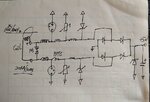tony_lth
Advanced Member level 5
Hi, Gurus,
Now I design a CT loop protection circuit.
The CT loop acquires power from 110KV/50Hz to drive a wireless sensor,.
the CT loop will bound to the high voltage wire (normally 500A) directly in the top of a tower.
I wonder if it can protect the following wireless circuit from lighting etc, and how to select the components?
Such as after the 1st gas tube(20kA/10uS), I would place a PPTC, how to determine its spec?
Could you comment it?
Best,
Tony Liu
Now I design a CT loop protection circuit.
The CT loop acquires power from 110KV/50Hz to drive a wireless sensor,.
the CT loop will bound to the high voltage wire (normally 500A) directly in the top of a tower.
I wonder if it can protect the following wireless circuit from lighting etc, and how to select the components?
Such as after the 1st gas tube(20kA/10uS), I would place a PPTC, how to determine its spec?
Could you comment it?
Best,
Tony Liu


